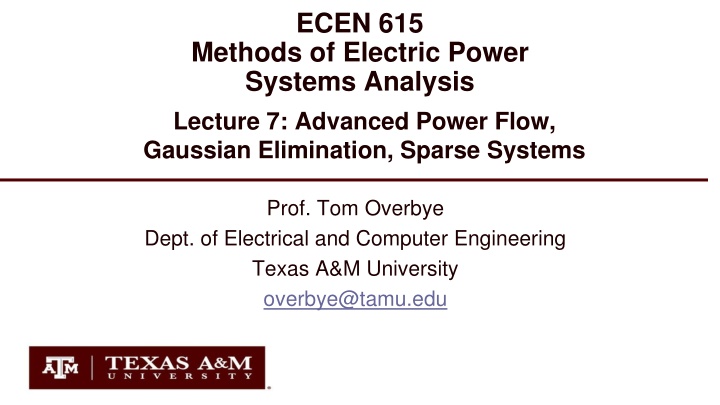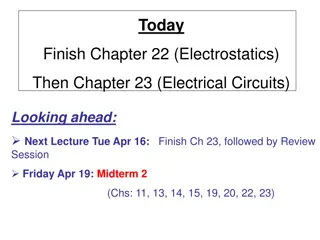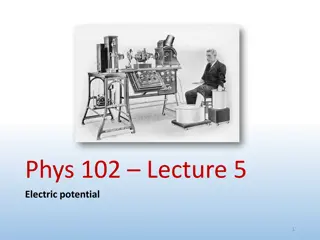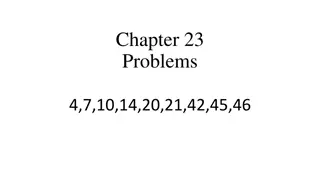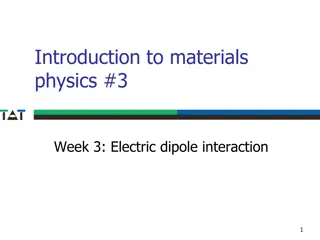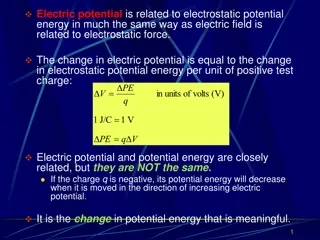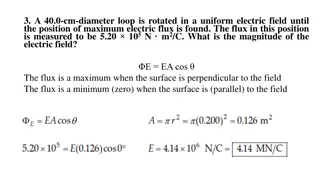Advanced Power Flow Techniques in Electric Power Systems
This lecture covers advanced power flow analysis methods such as Gaussian elimination and decoupled power flow. Explore the decoupling approximation and off-diagonal Jacobian terms for efficient power system analysis. Stay updated with announcements and examples related to power flow solutions.
Download Presentation

Please find below an Image/Link to download the presentation.
The content on the website is provided AS IS for your information and personal use only. It may not be sold, licensed, or shared on other websites without obtaining consent from the author.If you encounter any issues during the download, it is possible that the publisher has removed the file from their server.
You are allowed to download the files provided on this website for personal or commercial use, subject to the condition that they are used lawfully. All files are the property of their respective owners.
The content on the website is provided AS IS for your information and personal use only. It may not be sold, licensed, or shared on other websites without obtaining consent from the author.
E N D
Presentation Transcript
ECEN 615 Methods of Electric Power Systems Analysis Lecture 7: Advanced Power Flow, Gaussian Elimination, Sparse Systems Prof. Tom Overbye Dept. of Electrical and Computer Engineering Texas A&M University overbye@tamu.edu
Announcements Read Chapter 6 from the book The book presents the power flow using the polar form for the Ybus elements Homework 2 is due on Thursday September 22 The ECEN EPG dinner is Saturday October 1st at 5:00 pm at Prof. Davis s house. The address is 3810 Park Meadow Lane, Bryan, TX 77802. RSVP at https://forms.gle/6aye2butgCLDv6bz5by Sunday, September 25th. 1
Larger Sized Grid Power Flow Example Demonstration of some issues with solving power flows on larger cases Example is done using the 2000 bus synthetic grid from Homework 2 2
Decoupled Power Flow Rather than not updating the Jacobian, the decoupled power flow takes advantage of characteristics of the power grid in order to decouple the real and reactive power balance equations There is a strong coupling between real power and voltage angle, and reactive power and voltage magnitude There is a much weaker coupling between real power and voltage magnitude, and reactive power and voltage angle Key reference is B. Stott, Decoupled Newton Load Flow, IEEE Trans. Power. App and Syst., Sept/Oct. 1972, pp. 1955-1959 3
Decoupled Power Flow Formulation General form of the power flow problem V ( ) v ( ) v P P V ( ) v ( ) v P x ( ) ( ) v = = f x ( ) ( ) v ( ) v ( ) v ( ) v Q x V ( ) Q Q where ( ) v + x ( ) P P P 2 2 2 D G ( ) v = P x ( ) ( ) v + x ( ) P P Gn P n Dn 4
Decoupling Approximation ( ) v ( ) v P V Q Usually the off-diagonal matrices, and are small. Therefore we approximate them as zero: V can be decoupled = ( ) v P 0 ( ) v ( ) v P x ( ) ( ) v = = f x ( ) ( ) v ( ) v ( ) v Q Q x V ( ) 0 Then the problem 1 1 ( ) v ( ) v P Q V ( ) v ( ) v ( ) v ( ) v = ( ) ( ) P x V Q x 5
Off-diagonal Jacobian Terms Justification for Jacobian approximations: 1. Usually r << x, therefore G B ij ij 2. Usually is small so sin 0 ij ij Therefore P V ( ) = + i cos sin 0 V G B i ij ij ij ij j Q ( ) = + i cos sin 0 V V G B i j ij ij ij ij j By assuming the elements are zero, we only have to do the computations 6 6
Decoupled N-R Region of Convergence The high solution ROC is actually larger than with the standard NPF. Obviously this is no a good a way to get the low solution 7
Fast Decoupled Power Flow, cont. By continuing with Jacobian approximations we can obtain a reasonable approximation that is independent of the voltage magnitudes/angles. This means the Jacobian need only be built/inverted once per power flow solution This approach is known as the fast decoupled power flow (FDPF) FDPF uses the same mismatch equations as standard power flow (just scaled) so it should have same solution The FDPF is widely used, though usually only for an approximate solution Key fast decoupled power flow reference is B. Stott, O. Alsac, Fast Decoupled Load Flow, IEEE Trans. Power App. and Syst., May 1974, pp. 859-869 Modified versions also exist, such as D. Jajicic and A. Bose, A Modification to the Fast Decoupled Power Flow for Networks with High R/X Ratios, IEEE Transactions on Power Sys., May 1988, pp. 743-746 8
FDPF Approximations The FDPF makes the following approximations: = = = 1. G 0 ij 2. 3. 1 V i = sin 0 cos 1 ij ij To see the impact on the real power equations recall n = + = P ( cos sin ) VV G B P P i i k ik ik ik ik Gi Di = 1 k Which can also be written as n P V P P = + = i Gi Di ( cos sin ) V G B k ik ik ik ik V = 1 i i k 9
FDPF Approximations With the approximations for the diagonal term we get = n P i B B ik ii = 1 i k k i i) with = and = G 0 V 1 The for the off-diagonal terms (k P B = i cos B ik ik ik k Hence the Jacobian for the real equations can be approximated as B 10
FPDF Approximations For the reactive power equations we also scale by Vi n V V G = = = Q ( sin cos ) B Q Q i i k ik ik ik ik Gi Di 1 k n Q V Q Q = = i Gi Di ( sin cos ) V G B k ik ik ik ik V = 1 i i k For the Jacobian off-diagonals we get Q B V = i cos B ik ik ik k 11
FDPF Approximations And for the reactive power Jacobian diagonal we get n Q V = i 2 B B B ii ik ii = 1 i k k i As derived the real and reactive equations have a constant Jacobian equal to B Usually modifications are made to omit from the real power matrix elements that affect reactive flow (like shunts) and from the reactive power matrix elements that affect real power flow, like phase shifters We ll call the real power matrix B and the reactive B 12
FDPF Cautions The FDPF works well as long as the previous approximations hold for the entire system With the movement towards modeling larger systems, with more of the lower voltage portions of the system represented (for which r/x ratios are higher) it is quite common for the FDPF to get stuck because small portions of the system are ill-behaved The FDPF is commonly used to provide an initial guess of the solution for contingency analysis 14
DC Power Flow The DC power flow makes the most severe approximations: completely ignore reactive power, assume all the voltages are always 1.0 per unit, ignore line conductance This makes the power flow a linear set of equations, which can be solved directly P sign convention is generation is positive 1 = B P The term dc power flow actually dates from the time of the old network analyzers (going back into the 1930 s) Not to be confused with the inclusion of HVDC lines in the standard NPF 15
DC Power Flow References I don t think a classic dc power flow paper exists; a nice formulation is given in our book Power Generation and Control book by Wood, Wollenberg and Sheble The August 2009 paper in IEEE Transactions on Power Systems, DC Power Flow Revisited (by Stott, Jardim and Alsac) provides good coverage T. J. Overbye, X. Cheng, and Y. Sun, A comparison of the AC and DC power flow models for LMP Calculations, in Proc. 37th Hawaii Int. Conf. System Sciences, 2004, compares the accuracy of the approach 16
DC Power Flow Example Example from Power System Analysis and Design, by Glover, Overbye, Sarma, 6th Edition 17
DC Power Flow in PowerWorld PowerWorld allows for easy switching between the dc and ac power flows (case Aggieland37) To use the dc approach in PowerWorld select Tools, Solve, DC Power Flow Aggieland Power and Light SLACK345 A 39% MVA A 67% MVA Total Load 1421.0 MW 1.00 pu HOWDY345 862 MW slack Total Losses: 0.00 MW A A A 90% MVA 90% MVA 65% MVA 1.00 pu SLACK138 TEXAS345 1.00 pu HOWDY138 A 94% MVA A 21% MVA 1.00 pu A 35% MVA A TEXAS138 1.00 pu 53 MW 0 Mvar 90% MVA 1.00 pu 29 MW 0 Mvar A 0.0 Mvar 1.0875 tap 64% MVA 1.00 pu HOWDY69 100 MW 287.2 MW A 27 MW 0 Mvar A 123% MVA 1.00 pu TEXAS69 BATT69 60% MVA 0 Mvar 1.00 pu A 37 MW 0 Mvar 1.00 pu NORTHGATE69 39% MVA A A 17% MVA 87% MVA A 23% MVA 12MAN69 1.00 pu BONFIRE69 A A 115.0 MW 27% MVA 34 MW 0 Mvar 103% MVA WHITE138 A Notice there are no losses 74% MVA A 36% MVA CENTURY69 20 MW 0 Mvar 0.0 Mvar 50 MW A 31 MW 0 Mvar 73% MVA PLUM138 1.00 pu WEB138 A 75% MVA 1.00 pu GIGEM69 1.00 pu A A 1.0625 tap MAROON69 93 MW 0 Mvar 72% MVA 68% MVA REVEILLE69 49 MW 0 Mvar 82 MW 0 Mvar 59 MW 0 Mvar 1.00 pu A 77% MVA WEB69 TREE69 1.00 pu 1.00 pu 0.0 Mvar 0 MW 100 MW 1.00 pu A 0.0 Mvar 0 Mvar A MVA 43% MVA 0.0 Mvar 5 MW FISH69 50 A 55% MVA A MW 55% MVA A 93 MW 0 Mvar 57% MVA 1.000 pu KYLE138 A SPIRIT69 1.00 pu 23% MVA 1.00 pu 1.0000 tap A A 22% MVA 26% MVA A YELL69 26% MVA 35 MW 0 Mvar 0.0 Mvar A 14% MVA 1.00 pu A KYLE69 18% MVA 1.00 pu A 25 MW 0 Mvar 61 MW 0 Mvar 110 MW A MVA 90 MW A MVA 1.00 pu 22% MVA A 33% MVA 58 MW 0 Mvar 1.00 pu A A 62% MVA 57% MVA A 0.0 Mvar 0.0 Mvar 14% MVA 96 MW 0 Mvar BUSH69 A 29% MVA 1.00 pu 1.00 pu MSC69 A A 65% MVA 70 MW 0 Mvar 59 MW 0 Mvar RING69 MVA 1.00 pu RUDDER69 RELLIS69 1.00 pu 38 MW 0 Mvar 36 MW 0 Mvar 10 MW 22 MW 0 Mvar A A A 81% MVA 84% MVA 58% MVA 45 MW 18 1.00 pu AGGIE138 AGGIE345 RELLIS138 1.00 pu deg REED69 1.00 pu 0 1.00 pu HULLABALOO138 A 65% MVA
Linear System Solution: Introduction A problem that occurs in many is fields is the solution of linear systems Ax = b where A is an n by n matrix with elements aij, and x and b are n- vectors with elements xi and bi respectively In power systems we are particularly interested in systems when n is relatively large and A is sparse How large is large is changing A matrix is sparse if a large percentage of its elements have zero values Goal is to understand the computational issues (including complexity) associated with the solution of these systems 19
Introduction, cont. Sparse matrices arise in many areas, and can have domain specific structures Symmetric matrices Structurally symmetric matrices Tridiagnonal matrices Banded matrices A good (and free) book on sparse matrices is available at www-users.cs.umn.edu/~saad/IterMethBook_2ndEd.pdf ECEN 615 is focused on problems in the electric power domain; it is not a general sparse matrix course Much of the early sparse matrix work was done in power! 20
Gaussian Elimination The best known and most widely used method for solving linear systems of algebraic equations is attributed to Gauss Gaussian elimination avoids having to explicitly determine the inverse of A, which is O(n3) Gaussian elimination can be readily applied to sparse matrices Gaussian elimination leverages the fact that scaling a linear equation does not change its solution, nor does adding on linear equation to another + = + = 2 4 10 2 5 x x x x 1 2 1 2 21
Gaussian Elimination, cont. Gaussian elimination is the elementary procedure in which we use the first equation to eliminate the first variable from the last n-1 equations, then we use the new second equation to eliminate the second variable from the last n-2 equations, and so on After performing n-1 such eliminations we end up with a triangular system which is easily solved in a backward direction 22
Example 1 We need to solve for x in the system 2 6 2 4 3 5 5 2 1 0 6 2 0 2 6 3 20 45 x x x x 1 = 2 3 3 30 4 The three elimination steps are given on the next slides; for simplicity, we have appended the r.h.s. vector to the matrix First step is set the diagonal element of row 1 to 1 (i.e., normalize it)
Example 1, cont. Eliminate x1 by subtracting row 1 from all the rows below it 1 3 1 multiply row by 1 1 0 10 2 2 2 multiply row and add to row by 1 6 2 15 0 4 3 2 multiply row and add to row by 1 2 3 0 8 7 6 23 multiply row and add to row by 1 4 0 4 7 3 10 4 24
Example 1, cont. Eliminate x2 by subtracting row 2 from all the rows below it 3 1 1 0 10 2 2 3 4 1 multiply row by 2 4 1 2 15 4 0 1 multiply row and add to row by 2 8 3 0 0 1 2 7 multiply row and add to row by 2 4 0 0 1 1 5 4 25
Example 1, cont. Elimination of x3 from row 3 and 4 3 1 1 0 10 2 2 3 4 1 2 15 4 0 1 1 multiply row by 3 0 0 1 2 7 multiply row and add to row by 3 -1 0 0 0 1 2 4 26
Example 1, cont. Then, we solve for x by going backwards , i.e., using back substitution: x = 2 4 = = x x x 2 7 3 3 4 3 3 4 1 2 15 4 + = = x x x x 7 2 3 4 2 3 2 1 2 + = = x x x x 10 1 1 2 3 1 27
LU Decomposition What we did with Gaussian elimination can be thought of as changing the form of the matrix to create two matrices with special structure One matrix, shown on the last slide, is upper triangular The second matrix, a lower triangular one, keeps track of the operations we did to get the upper triangular matrix These concepts will be helpful for a computer implementation of the algorithm and for its application to sparse systems 28
LU Decomposition Theorem Any nonsingular matrix A has the following factorization: A = LU where U could be the upper triangular matrix previously developed (with 1 s on its diagonals) and L is a lower triangular matrix defined by j i (j i j ) 1 a = j i ij 0 29
LU Decomposition Application As a result of this theorem we can rewrite Ax = LUx = b y = Ux Ly = b Define Then Can also be set so U has non unity diagonals Once A has been factored, we can solve for x by first solving for y, a process known as forward substitution, then solving for x in a process known as back substitution In the previous example we can think of L as a record of the forward operations preformed on b. 30
LDU Decomposition In the previous case we required that the diagonals of U be unity, while there was no such restriction on the diagonals of L An alternative decomposition is % A = LDU % L = LD with where D is a diagonal matrix, and the lower triangular matrix is modified to require unity for the diagonals (we ll just use the LU approach in 615) 31
Symmetric Matrix Factorization The LDU formulation is quite useful for the case of a symmetric matrix = = = = U L A = U DU T A A = LDU % % A % T T T U DL A T T Hence only the upper triangular elements and the diagonal elements need to be stored, reducing storage by almost a factor of 2 32
Symmetric Matrix Factorization There are also some computational benefits from factoring symmetric matrices. However, since symmetric matrices are not common in power applications, we will not consider them in-depth However, topologically symmetric sparse matrices are quite common, so those will be our main focus 33
Pivoting An immediate problem that can occur with Gaussian elimination is the issue of zeros on the diagonal; for example 0 1 2 A = 3 This problem can be solved by a process known as pivoting, which involves the interchange of either both rows and columns (full pivoting) or just the rows (partial pivoting) Partial pivoting is much easier to implement, and actually can be shown to work quite well 34
Pivoting, cont. In the previous example the (partial) pivot would just be to interchange the two rows 2 3 0 1 A = % obviously we need to keep track of the interchanged rows! Partial pivoting can be helpful in improving numerical stability even when the diagonals are not zero When factoring row k interchange rows so the new diagonal is the largest element in column k for rows j >= k 35
LU Algorithm Without Pivoting Processing by row We will use the more common approach of having ones on the diagonals of L. Also in the common, diagonally dominant power system problems pivoting is not needed. The below algorithm is in row form (useful with sparsity!) For i := 2 to n Do Begin // This is the row being processed For j := 1 to i-1 Do Begin // Rows subtracted from row i A[i,j] = A[i,j]/A[j,j] // This is the scaling For k := j+1 to n Do Begin // Go through each column in i A[i,k] = A[i,k] - A[i,j]*A[j,k] End; End; End; 36
LU Example Starting matrix 20 12 12 3 5 6 A = 5 4 8 A[2,2]= A[2,2]-A[2,1]*A[1,2] =12-(-0.25)*(-12) =9 A[2,3] = A[2,3]-A[2,1]*A[1,3] =-6 (-0.25)*(-5) = -7.25 First row is unchanged; start with i=2 Result with i=2, j=1; done with row 2 20 0.25 4 12 9 3 5 A = 7.25 8 37
LU Example, cont. Result with i=3, j=1; A[3,1]= A[3,1]/A[1,1] =-4/20= -0.2 A[3,2] = A[3,2] A[3,1]*A[1,2] A[3,2] = -3 (-0.2)*(-12) = -5.4 A[3,3] = 8 (-0.2)*(-5) = 7 20 0.25 0.2 12 9 5.4 5 A = 7.25 7 Result with i=3, j=2; done with row 3; done! A[3,2]= A[3,2]/A[2,2] =-5.4/9= -0.6 A[3,3] = A[3,3] A[3,2]*A[2,3] A[3,3] = 7 (-0.6)*(-7.25) =2.65 20 0.25 0.2 12 9 0.6 5 A = 7.25 2.65 38
LU Example, cont. Original matrix is used to hold L and U 20 = = 12 12 3 5 6 = A = LU 5 4 8 With this approach the original A matrix has been replaced by the factored values! 1 0 1 0.6 0 0 1 L 0.25 0.2 20 0 0 12 9 0 5 U 7.25 2.65 39
Forward Substitution b = Ly Forward substitution solves with values in b being over written (replaced by the y values) For i := 2 to n Do Begin // This is the row being processed For j := 1 to i-1 Do Begin b[i] = b[i] - A[i,j]*b[j] // This is just using the L matrix End; End; 40
Forward Substitution Example 10 Let = 20 b 30 1 0 1 0.6 0 0 1 = L From before 0.25 0.2 = = = [1] 10 [2] [3] y y y = 20 ( 0.25)*10 30 ( 0.2)*10 ( 0.6)*22.5 22.5 = 45.5 41
Backward Substitution y = Ux Backward substitution solves (with values of y contained in the b vector as a result of the forward substitution) For i := n to 1 Do Begin // This is the row being processed For j := i+1 to n Do Begin b[i] = b[i] - A[i,j]*b[j] // This is just using the U matrix End; b[i] = b[i]/A[i,i] // The A[i,i] values are <> 0 if it is nonsingular End 42
Backward Substitution Example 10 Let = 22.5 y 45.5 20 0 0 12 9 0 5 = U From before 7.25 2.65 = = = = [3] [2] x (1/ 2.65)*45.5 17.17 (1/9)* 22.5 ( 7.25)*17.17 x ( ) = 16.33 ( ) = [1] x (1/ 20)* 10 ( 5)*17.17 ( 12)*16.33 14.59 43
